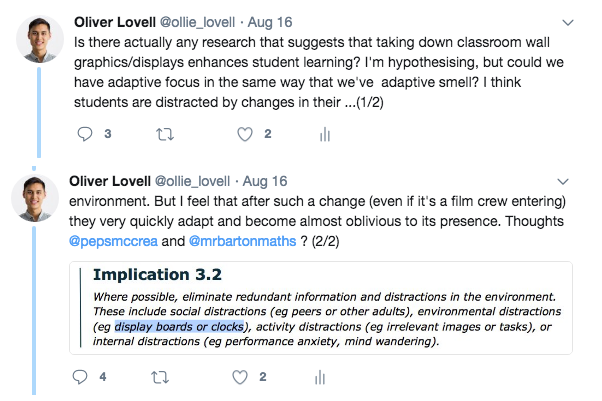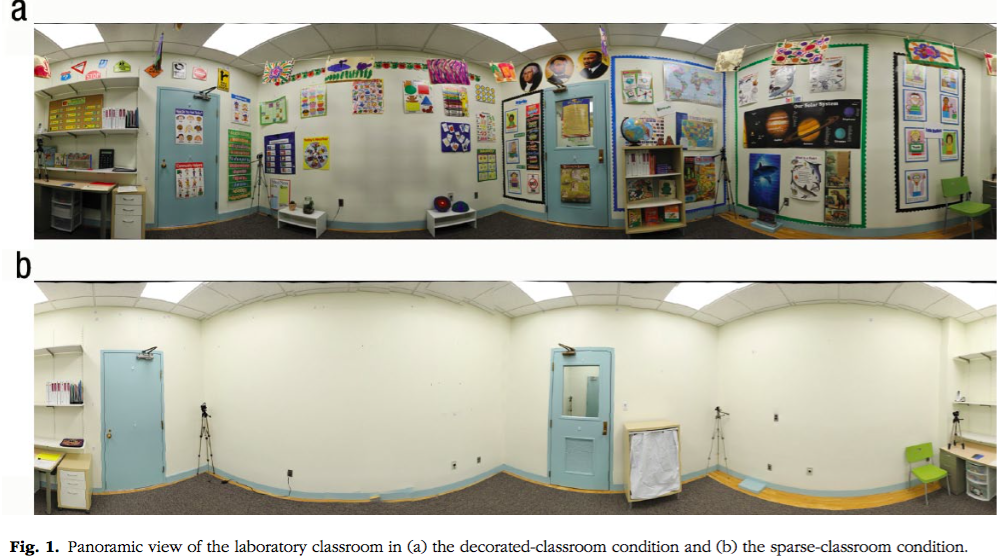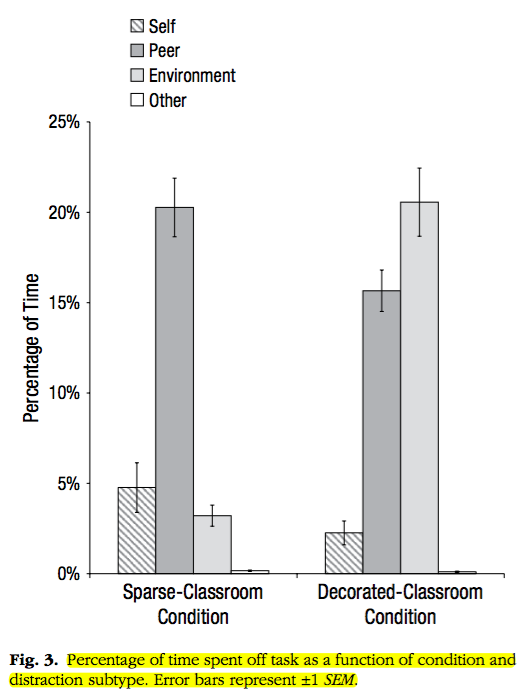About a week ago I posted a tweet that asked the following question?
Is there actually any research that suggests that taking down classroom wall graphics/displays enhances student learning? I'm hypothesising, but could we have adaptive focus in the same way that we've adaptive smell? I think students are distracted by changes in their …(1/2) environment. But I feel that after such a change (even if it's a film crew entering) they very quickly adapt and become almost oblivious to its presence. Thoughts @pepsmccrea and @mrbartonmaths ? (2/2)

I was grateful for a reply from Stephen Sutton (@ss2487) linking me to an article by Fisher, Godwin, and Seltman, entitled ‘Visual environment, attention allocation, and learning in young children: When too much of a good thing may be bad’
I thoroughly enjoyed reading this article, so thought it worthwhile sharing some of the findings.
The study sets out to examine the difference between the allocation of students attention, and student learning, in highly decorated vs. more sparsely decorated classrooms. Here's an image of the two classroom decoration protocols.
Research Design
The research design was excellent, here are the key points in a nutshell:
- The study included 24 kindergarten students
- The students participated in both the more and less-decorated conditions.
- Teaching was centred around 6 lessons, 3 of which were taught in the more, and 3 in the less-decorated protocols.
- A pre-test was administered, and the 6 lessons were allocated to the two protocols to minimise the impact of prior-knowledge on attainment.
- All lessons were taught by the same teacher, who was blind to the hypothesis (that the more sparse classroom would be associated with greater learning)
- The students were taught in the classrooms for some time prior to the experimental lessons so that they could become acclimatised to each enviroement
Measures
One of the coolest things about this study was that it used two measures. The first was observer ratings of student time spent on task. The second was student learning. For the first, raters were again blind to the hypothesis of the study.
Outcomes
The first thing that's very clear from this study is that a classroom full of visually stimulating displays causes students to be more distracted by those displays. The authors write:
In the sparse-classroom condition, the children spent only 3.21% of instructional time engaged in environmental distractions, whereas in the decorated- classroom condition, they spent 20.56% of instructional time engaged in environmental distractions
And this is captured in the following graph:
Let's pause for a moment just to consider how massive this is. >20% of time spent on environmental distractions… WOW!
A mediation analysis revealed that it's highly unlikely that this outcome was due to anything other than the differences in classroom decorations.
The impact on student learning, which was measured as a difference between pre-test and post-test scores, was also significant. It's reported:
Pairwise comparisons indicated that the children’s learning gains were higher in the sparse-classroom condition (M = 33%, SD = 22) than in the decorated-classroom condition (M = 18%, SD = 19), paired-sample t(22) = 3.49, p = .002, Cohen’s d = 0.73.
Interestingly, the effect wasn't present for all students. Whilst the altered visual environment did distract the vast majority of students (85%), there was a small minority for whom the impact of the more decorated environment wasn't significant. This prompted me to wonder to what extent this student characteristic (lower susceptibility to visual distraction) could be a reliable predictor of longer term success. i.e., could we have a marshmallow test 2.0 here? (let's not get ahead of ourselves though, just an interesting question…)
Discussion
My key takeaways here are:
- Students learnt significantly more, and were significantly less distracted, in the more sparse classroom environment
- There was a negative relationship (r=-0.50) between time spent off task and learning
- The mechanism appears clear: More decorated classroom – > more time off task -> less learning
- The effect greatly varied across students, but was robust for the majority (85%) of participants.
But, as always, it's important for us to consider the limitations. Some of these are:
- The sample size is clearly very small
- Longer term exposure to a visually stimulating environment could reduce distractions cause by it, as students become more accustomed (though other research by Godwin & Fisher, 2012, suggests that 2 weeks still isn't long enough for distraction to significantly decrease)
- It's unclear whether or not these findings can be generalised to other contexts, especially other year levels (e.g., older students).
All up, I think that this is a very important paper, and it adds much weight to the suggestion that teachers should give serious consideration to the ways that their classroom environments could be increasing the chances that their students will spend time off task. That said, it's important to note that the authors clearly state that ‘We are not advocating sterilizing the learning environments of young children by removing all decorations, artwork, or educational displays.' and indicated that (you guessed it), we need more research!
In this study, decorated condition was associated with 10% increase in total time spent off task, this is a significant loss in instructional time. In education we are constantly faced with tradeoffs, hopefully this study helps teachers to more accurately weigh up the tricky balancing act between making their classrooms a place where students feel safe, welcome, and stimulated, and where highly focussed learning can take place.
Edit
Daniel Willingham replied on Twitter with the following.
I had a different take on this study https://t.co/tWQGTh4WVu
— Daniel Willingham (@DTWillingham) August 26, 2018
I had a read of his take and it's good, here's my response…
Dan says:
‘During the familiarization sessions, there were a moderate number of decorations on the walls. During the experimental sessions, the walls were either bare, or quite covered.’
Great point, this isn’t a distinction I noticed when I read the paper, I just read ‘familiarization sessions’ and didn’t look carefully enough at the fact that it wasn’t based upon the fully decorated classroom. This is definitely a confounding factor.
Dan also warns that:
it seems likely to me that kids would habituate to the wall decorations in time. The authors address that possibility in their paper, citing data presented at a conference (but not yet published) showing that kids distraction was above baseline levels two weeks after the introduction of a distracting classroom environment.
This was my gut feeling too, which I expressed in my initial tweet which lead me to this paper…
 I thought the authors addressed this quite well with their comment in the discussion section
I thought the authors addressed this quite well with their comment in the discussion section
In a recent study, we videotaped groups of kindergarten children who received instruction in a decorated classroom every day for 2 weeks (Godwin & Fisher, 2012). Before receiving instruction in the decorated classroom, the children participated in a weeklong series of lessons in a sparse classroom, which served as a baseline. In the sparse classroom, the children spent 29% of instructional time off task. Off-task behavior in the decorated classroom was significantly greater in both Week 1 (48% of time spent off task) and Week 2 (46% of time spent off task). It is possible that greater habituation might occur with longer exposure.
However, I’m glad that Dan went to the reference (a conference paper) and checked out the abstract. I just checked this out too and they do indeed refer to ‘a significant decrease in the proportion of time children attended to the environment between week 1 and week 2’, so it seems peculiar that they seem to have mis-represented their own conference paper by not mentioning this in the discussion paper of the 2014 research (and instead suggesting a decrease of only 2% in time spent off task from weeks 1 to 2).
I'm grateful to Dan for him sharing his analysis, it brought out limitations in the study that I didn’t spot.

